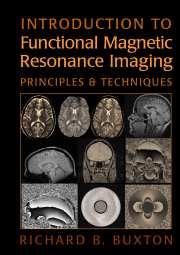Introduction
Published online by Cambridge University Press: 05 September 2013
Summary
Just over 50 years ago, two scientific developments occurred; these advancements are the deep roots of modern functional neuroimaging and the primary role played by functional magnetic resonance imaging (fMRI). In 1948, S. Kety and C. Schmidt described the nitrous oxide technique for measuring cerebral blood flow (CBF). For the first time it was possible to measure CBF in human subjects, providing a new window on the physiological functioning of the human brain. Although the original technique only measured global CBF, subsequent techniques with radioactive tracers ultimately led in the 1970s and 1980s to positron emission tomography (PET) methods, which made possible local measurements of CBF with a spatial resolution better than one cubic centimeter. These techniques were the initial basis for functional neuroimaging to map patterns of activation in the working human brain. Although the sophistication of these techniques has steadily improved, they are all based on the fundamental ideas introduced by Kety and Schmidt.
At about the same time that Kety and Schmidt were working to measure CBF, two physics research groups led by E. Purcell and F. Bloch demonstrated for the first time the phenomenon of nuclear magnetic resonance (NMR). Their seminal work in 1946 provided a sensitive tool for studying subtle magnetic properties of atomic nuclei, but it is unlikely that anyone at the time could have imagined the practical applications of NMR that we have today. From basic physics studies, NMR moved to analytical chemistry applications, and in the 1970s NMR imaging was developed. As clinical applications grew, the N in NMR was dropped in the medical jargon, to avoid confusion with nuclear medicine techniques.
Information
- Type
- Chapter
- Information
- Introduction to Functional Magnetic Resonance ImagingPrinciples and Techniques, pp. ix - xiiPublisher: Cambridge University PressPrint publication year: 2002
